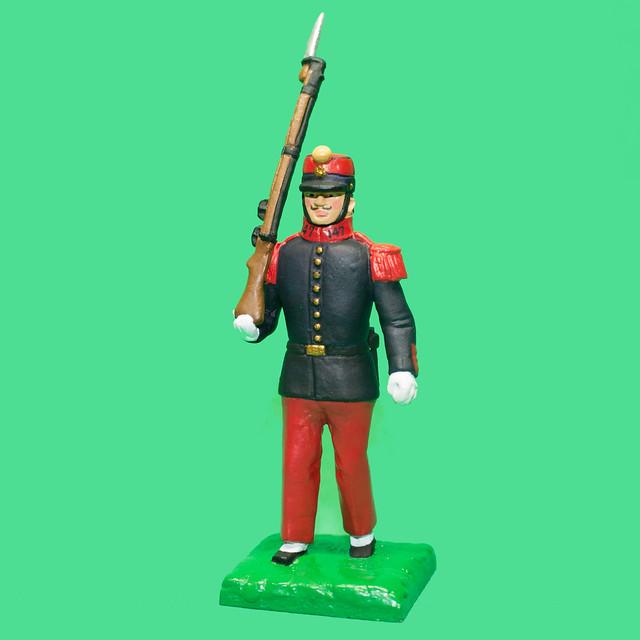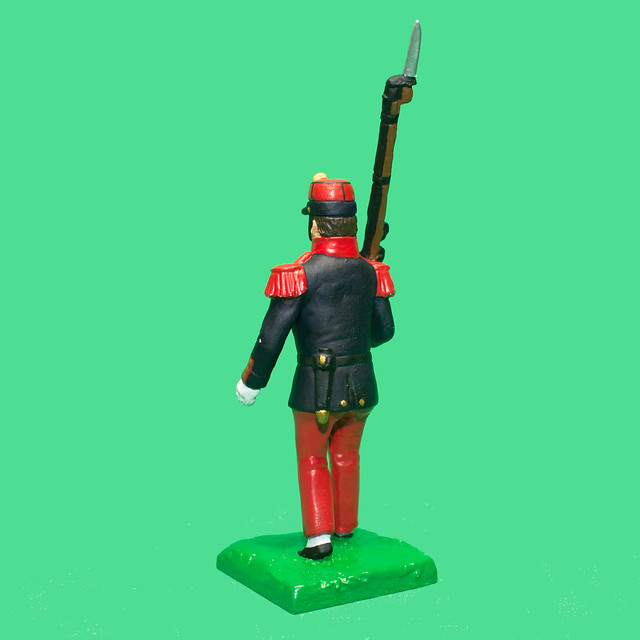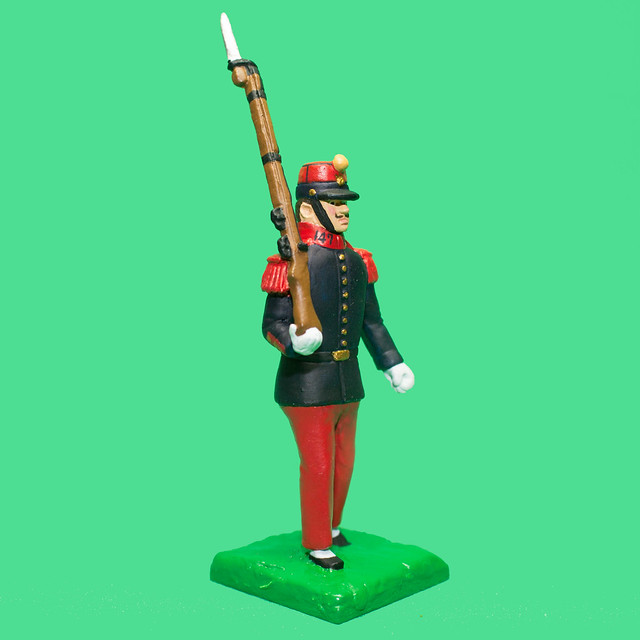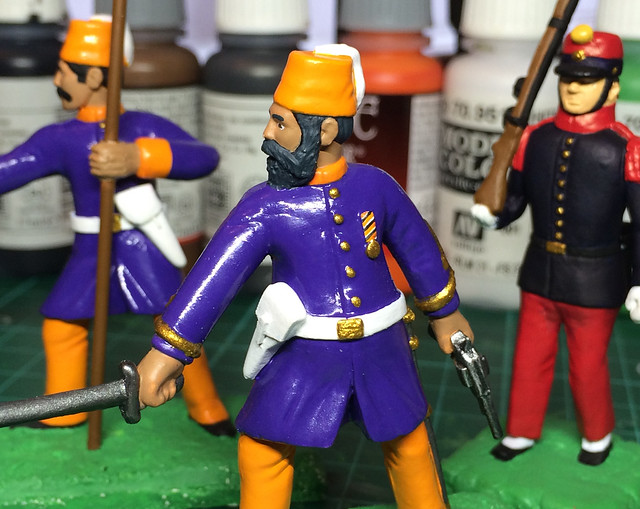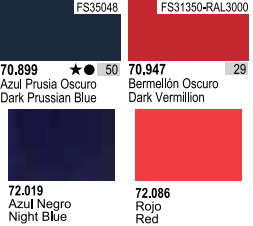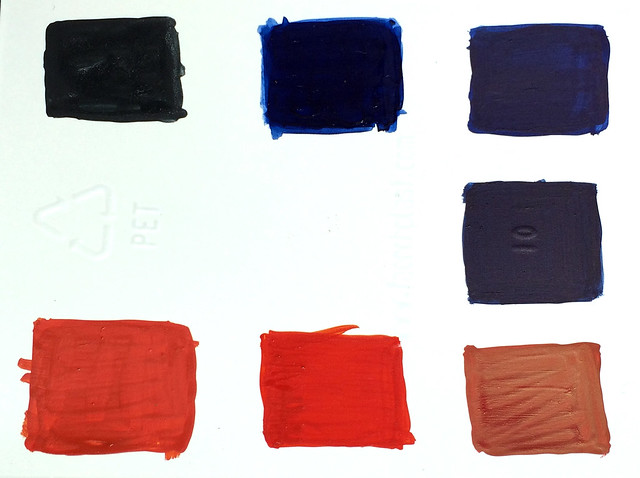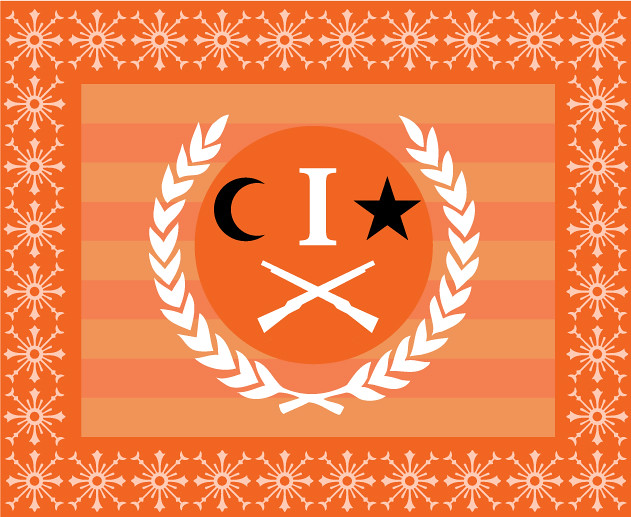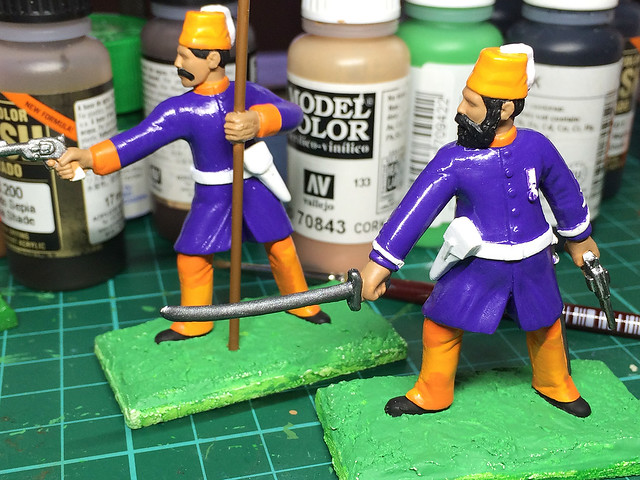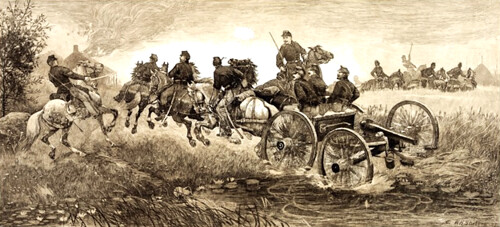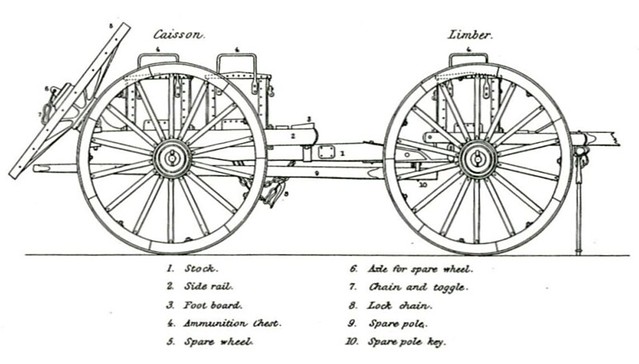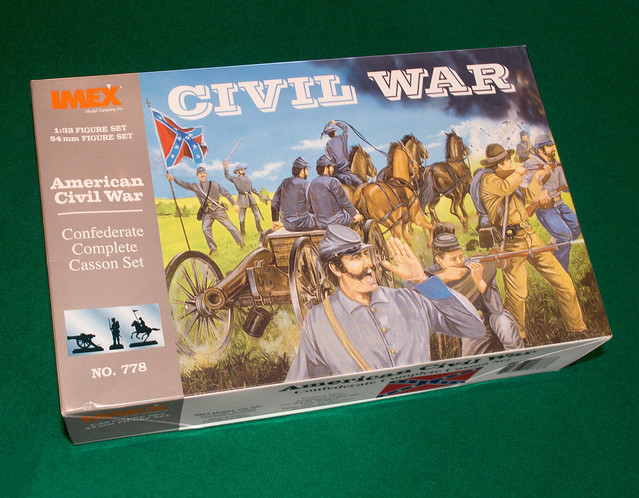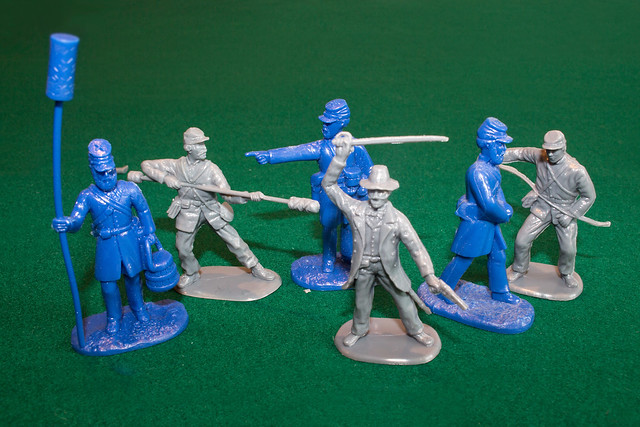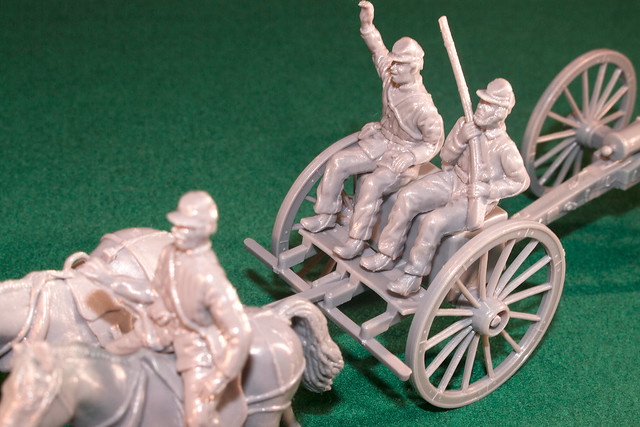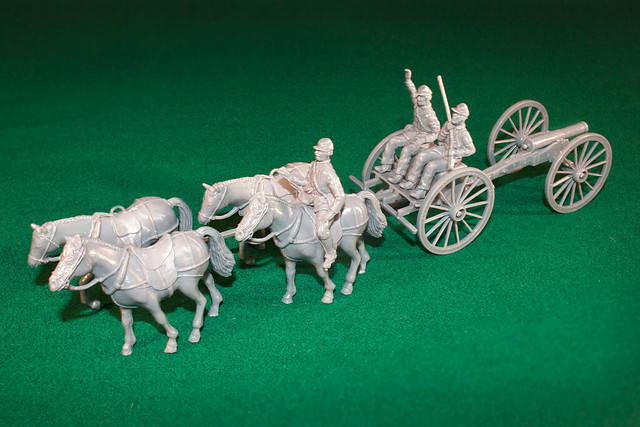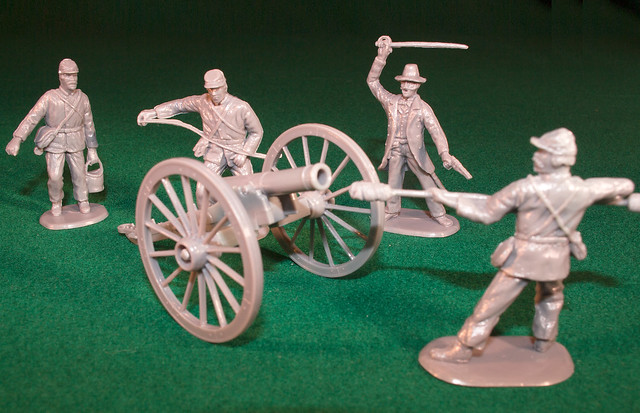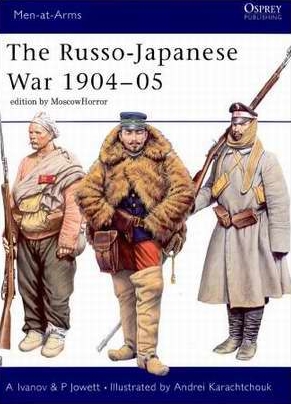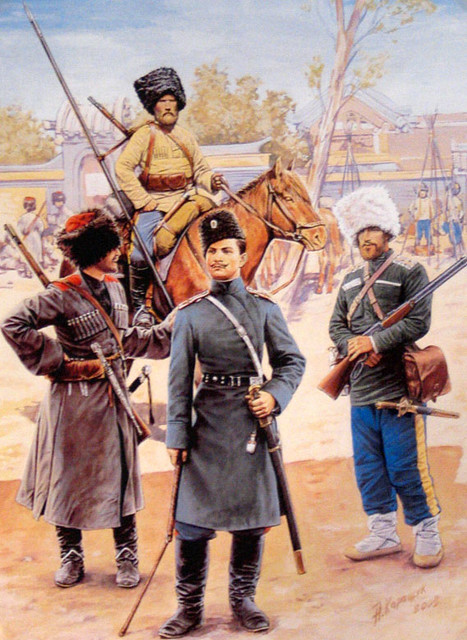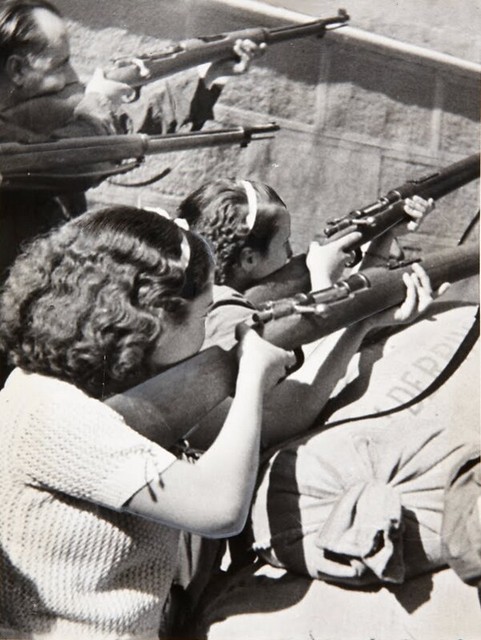Australia 35 - Scotland 34...If nothing else this result got me to pour my despondency into my painting! So much so that I actually completed my test painting of my Black Hat 54mm c. 1890 French Infantryman. Every cloud has a silver lining I suppose.
So here's the result (unvarnished)...
There are certain parts of my interpretation of the uniform that I am a bit unsure about - reference material of this exact period being somewhat scarce or ambiguous - but hopefully experts will find my soldier a spirited attempt.
Next I will give it a coat of varnish and then work on completing the construction of the rest of his regiment.
Postscript: About the rifle - The French rifle of the time should have been the Lebel Model 1886 rifle, which this 'toy' soldier clearly doesn't have. I suspect that Black Hat have produced a 'generic' model of a rifle which it uses for all it's late 19th century 54mm soldiers.
I think this model is based on a British Lee-Metford judging by the magazine. Perhaps I should have filed off the magazine and painted a fake receiver to make it look more like a Lebel?
Being the Ethereal Embassy for the Kingdom of Molatero and it's participation in the Funny Little Wars
Monday, 19 October 2015
Sunday, 18 October 2015
Sunday soldiers
Just a very minor update of what's going on in Molatero on this relaxed Sunday morning. This isn't a particularly focused post, just a general workbench snapshot.
I've been tarting up a few of my current soldier models, creeping slowly towards completion...
I've been tarting up a few of my current soldier models, creeping slowly towards completion...
Thursday, 15 October 2015
French 1905 uniform - colour tests
A bad case of the blues!
Time for a little break, I'm journeying west leaving the misty mountains of Molatero behind me and saying hello to the land of the Belle Époque as I start to plan the painting of my Black Hat French Infantry of the Line.
It took me some time to track down some pictorial reference for the French infantry uniform of the 1900 period, but eventually I came across a lovely lithograph (left). The trouble with lithograph reproductions is that the colour tints are a little 'washy' so they really don't give a true representation of actual colour intensity.
Take the blue of the tunic, for example. The artist's interpretation of the colour suggests that - overall - it is a mid-blue. This is due to the semi-transparent nature of the colour medium used and is also an artistic 'impression' of the colour to emphasis that the tunic is, indeed, blue.
So, while this illustration put me on the right track as far as the general colour scheme for the French uniform of time is concerned I was a little suspicious about the trueness of the colours. I'd much rather have some photographic reference to go by. And once again I got lucky as I came across a rather nice photo on good old Wikipedia...
"Cadets of Saint-Cyr wear in full dress (grande tenue) a special uniform, derived from the 1845 Regulations Infantry Officer Dress. This dress incorporates a dark-blue tunic, red trousers and a shako with red and white plumes. Facings are light blue, as is the képi worn on less formal occasions. Red fringed epaulettes are worn by cadets and yellow by cadet-officers. This traditional uniform was worn by both cadets and instructors at Saint-Cyr from 1845 until 1914 and then again from 1930 until 1939." Wikipedia
As you can see from the above photo the French tunic's 'blue' appears almost black and is very similar to the 'blue' of the British Police dress uniform in it's darkness. Neither is the red of the trousers a vidid red (nor a scarlet) but rather a subdued crimson (what the games paint ranges likes to call 'blood red'). It just goes to show that artists cannot be trusted! ;)
Vallejo paint equivalents
I had been rather enamoured by Tamiya acrylics because of their opaqueness, but they are rather difficult to work with. Vallejo acrylics are - I have found - a lot more user friendly and have a far wider range. I'd much rather work with a colour straight out of a bottle instead of mixing a colour, it makes it easy to replicate the same colour across numerous toy soldiers.
So I've been looking through the various Vallejo acrylic colour ranges to get the nearest equivalents to the photo reference I have. Unfortunately it look like I will have to bite the bullet and do some subtle mixing as the darkest Vallejo blues are still probably a bit light.
Colour and scale (and distance)
Ironically, after much consideration, I find myself considering taking a leaf out of the lithograph artists's book and tweaking the colour for 'effect'. The problem is one of scale and distance - that while Vallajo's 'Night Blue' might seem to be lighter than the blue Saint-Cyr cadet's tunics one must imagine the colour painted onto a 1/32 figure which will be mostly viewed from a distance of about 5 feet or so.
Skipping the dreary diatribe about colour theory (or am I too late) - the only way I will really get a sense of whether Vallejo's darkest blue 'fits' is actually to see it on a test figure. (And then to view that test figure at the desired distance.)
Left: Just in case I checked Humbrol's acrylic paint range too. I'm not a fan of Humbrol and in any case the closest blue they have is a gloss.
Should you really want to look into colour scaling theory then I recommend you click here: Cybermodeler Online's Scale Modeling Magazine Scale Effects in Modeling By Michael Benolkin.
So, the punchline is - if I paint my French soldiers with a the visually correct shade of midnight blue they will to all intents and purposes look like they are dressed in black tunics at arms length!
Suck it and see - my initial painting test
OK, enough talking - let's have a test. First things first, I apply a primer coat - matt white AutoKote...
Second job was to go out and buy the paints that I had chosen. As it turned out none of my local stores had them! (After all that!) So I ended up buying a small collection of what the shops did have...
Swatches
Top row: Dark Sea Blue, Imperial Blue, Dark Prussian Blue
Middle row: Dark Prussian Blue with addition of small amount of black.
Bottom row: Scarlet, Bloody Red, Flat Red.
Not perfect...I'm still going to have to do some mixing to get the 'midnight' blue I have in mind. The best mix seems to be the Vallejo Dark Prussian Blue with a dab of black in it. The crimson is a mix too, a 50/50 combination of Vallejo Bloody Red and their Flat Red.
The result...
Well, it looks like the blue and crimson in the 'Saint-Cyr' cadet photo above (I think), but the blue was tricky. I would still prefer to get the colour I want straight out the bottle as the idea of having to mix this deep blue consistently across 20 figures makes me nervous. (For some reason this mix seems to dry quite quickly so mixing up a large batch isn't feasible.)
The crimson was, however, a success and is really easy to replicate. (Phew!) My interpretation may look a little too vivid but that may be because of my cameras flash.
So, should I keep on looking for that perfect blue? I want to get this right and I'm in no hurry - my options are to investigate the Tamiya Royal Blue and also to see what Humbrol have to offer. Though straying from Vallejo means I have to order online and I like being able to pop down to my local model shop for stuff like this. (My town has just lost another model shop so it's becoming ever more important to shop in what local model stores we still do have!)
In the meantime I'll continue on with this test piece and finish it off - glossing may have a part to play in what I decide.
Time for a little break, I'm journeying west leaving the misty mountains of Molatero behind me and saying hello to the land of the Belle Époque as I start to plan the painting of my Black Hat French Infantry of the Line.
It took me some time to track down some pictorial reference for the French infantry uniform of the 1900 period, but eventually I came across a lovely lithograph (left). The trouble with lithograph reproductions is that the colour tints are a little 'washy' so they really don't give a true representation of actual colour intensity.
Take the blue of the tunic, for example. The artist's interpretation of the colour suggests that - overall - it is a mid-blue. This is due to the semi-transparent nature of the colour medium used and is also an artistic 'impression' of the colour to emphasis that the tunic is, indeed, blue.
So, while this illustration put me on the right track as far as the general colour scheme for the French uniform of time is concerned I was a little suspicious about the trueness of the colours. I'd much rather have some photographic reference to go by. And once again I got lucky as I came across a rather nice photo on good old Wikipedia...
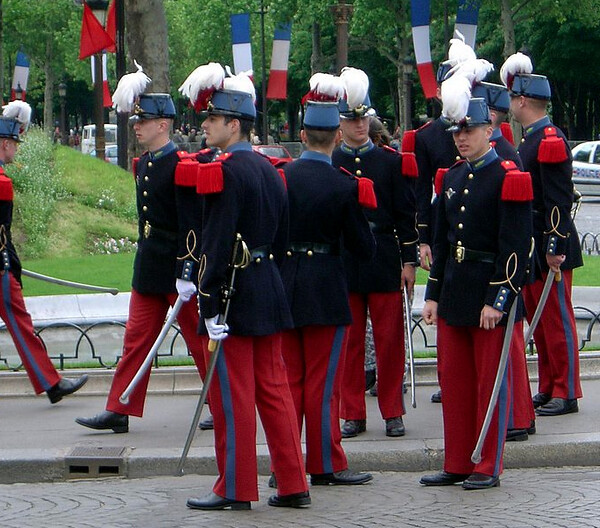 |
| The cadets of the Ecole Spéciale Militaire de Saint-Cyr, the French military academy, still wear the blue and red uniform of the French army before 1915. Source: Wikipedia (ironically, on an article on the colour 'blue'). |
"Cadets of Saint-Cyr wear in full dress (grande tenue) a special uniform, derived from the 1845 Regulations Infantry Officer Dress. This dress incorporates a dark-blue tunic, red trousers and a shako with red and white plumes. Facings are light blue, as is the képi worn on less formal occasions. Red fringed epaulettes are worn by cadets and yellow by cadet-officers. This traditional uniform was worn by both cadets and instructors at Saint-Cyr from 1845 until 1914 and then again from 1930 until 1939." Wikipedia
As you can see from the above photo the French tunic's 'blue' appears almost black and is very similar to the 'blue' of the British Police dress uniform in it's darkness. Neither is the red of the trousers a vidid red (nor a scarlet) but rather a subdued crimson (what the games paint ranges likes to call 'blood red'). It just goes to show that artists cannot be trusted! ;)
Vallejo paint equivalents
I had been rather enamoured by Tamiya acrylics because of their opaqueness, but they are rather difficult to work with. Vallejo acrylics are - I have found - a lot more user friendly and have a far wider range. I'd much rather work with a colour straight out of a bottle instead of mixing a colour, it makes it easy to replicate the same colour across numerous toy soldiers.
So I've been looking through the various Vallejo acrylic colour ranges to get the nearest equivalents to the photo reference I have. Unfortunately it look like I will have to bite the bullet and do some subtle mixing as the darkest Vallejo blues are still probably a bit light.
Colour and scale (and distance)
Ironically, after much consideration, I find myself considering taking a leaf out of the lithograph artists's book and tweaking the colour for 'effect'. The problem is one of scale and distance - that while Vallajo's 'Night Blue' might seem to be lighter than the blue Saint-Cyr cadet's tunics one must imagine the colour painted onto a 1/32 figure which will be mostly viewed from a distance of about 5 feet or so.
| Magnificent old Britains French Field Artillery set. The photo at this scale gives the impression of very dark - almost black - tunics. |
Skipping the dreary diatribe about colour theory (or am I too late) - the only way I will really get a sense of whether Vallejo's darkest blue 'fits' is actually to see it on a test figure. (And then to view that test figure at the desired distance.)
Left: Just in case I checked Humbrol's acrylic paint range too. I'm not a fan of Humbrol and in any case the closest blue they have is a gloss.
Should you really want to look into colour scaling theory then I recommend you click here: Cybermodeler Online's Scale Modeling Magazine Scale Effects in Modeling By Michael Benolkin.
So, the punchline is - if I paint my French soldiers with a the visually correct shade of midnight blue they will to all intents and purposes look like they are dressed in black tunics at arms length!
Suck it and see - my initial painting test
OK, enough talking - let's have a test. First things first, I apply a primer coat - matt white AutoKote...
Second job was to go out and buy the paints that I had chosen. As it turned out none of my local stores had them! (After all that!) So I ended up buying a small collection of what the shops did have...
Swatches
Top row: Dark Sea Blue, Imperial Blue, Dark Prussian Blue
Middle row: Dark Prussian Blue with addition of small amount of black.
Bottom row: Scarlet, Bloody Red, Flat Red.
Not perfect...I'm still going to have to do some mixing to get the 'midnight' blue I have in mind. The best mix seems to be the Vallejo Dark Prussian Blue with a dab of black in it. The crimson is a mix too, a 50/50 combination of Vallejo Bloody Red and their Flat Red.
The result...
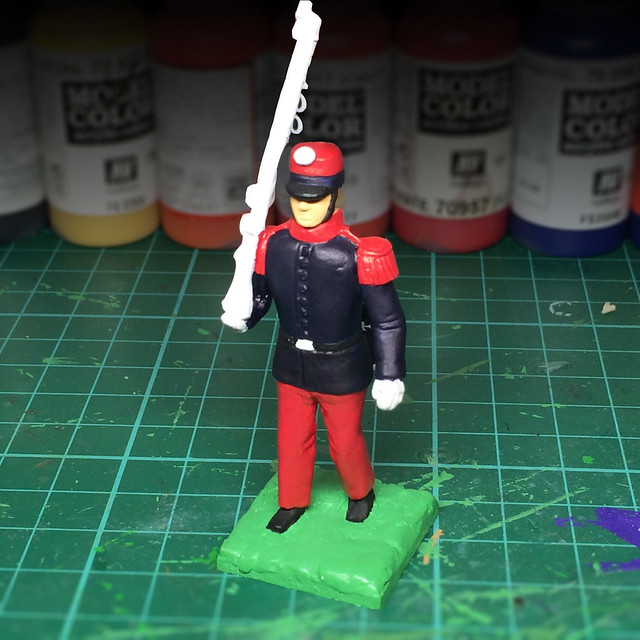 |
| Still only partially painted, but the tunic and trousers are done. |
Well, it looks like the blue and crimson in the 'Saint-Cyr' cadet photo above (I think), but the blue was tricky. I would still prefer to get the colour I want straight out the bottle as the idea of having to mix this deep blue consistently across 20 figures makes me nervous. (For some reason this mix seems to dry quite quickly so mixing up a large batch isn't feasible.)
The crimson was, however, a success and is really easy to replicate. (Phew!) My interpretation may look a little too vivid but that may be because of my cameras flash.
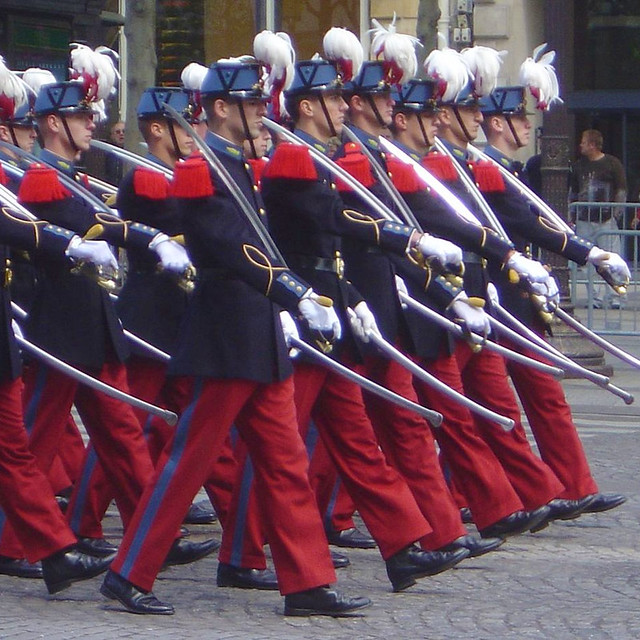 |
| 'Saint-Cyr' cadets again, be a nice future project to do a unit of these gentlemen! Source: Wikipedia. |
So, should I keep on looking for that perfect blue? I want to get this right and I'm in no hurry - my options are to investigate the Tamiya Royal Blue and also to see what Humbrol have to offer. Though straying from Vallejo means I have to order online and I like being able to pop down to my local model shop for stuff like this. (My town has just lost another model shop so it's becoming ever more important to shop in what local model stores we still do have!)
In the meantime I'll continue on with this test piece and finish it off - glossing may have a part to play in what I decide.
Wednesday, 14 October 2015
Burkish flag ready!
I had a bit of a panic, a while ago I had a rather nasty work data disaster - despite being careful to back-up my work files when a faulty drive corrupted my files those files were then backed-up over my copies! (I used a piece of software which automatically managed my back-ups.)
Why am I telling you this? Because I just happened to have saved my Burkish infantry regimental flag designs onto this hard drive!
Anyway, the good news is that I have now modified my back-up strategy AND while clearing out my Cloud-based storage I discovered another copy of my Burkish flag design (I often make multiple copies of files precisely abecause I am paranoid about losing work). So here's my Burkish flag design in all it's glory...
I've tried to give the flag an 'Ottoman' feel to reflect the Middle-Eastern influence of my imaginary Burkish Sultanate. It's actually a little over-ornate compared to historical Ottaman battle-flags but I've borrowed and modified various different motif to create my Burkish one.
What I have to work out next is how to turn my digital design into a mini-flag to mount on my toy soldier's flag pole. Not difficult but I will double check some of the TVAG flag designs I got with the Funny Little Wars rules for sizing.
Practically speaking, I got some good tips for making flags from that prolific FLW enthusiast, Mr. Tim Gow. So I'm off into town to buy some double sided sticky tape! I'm looking forward to putting my printed design together as this will be the icing on the cake, so to speak...
Which reminds me, I must buy some tea-cakes today. My daughter is popping by for a visit!
| The Burkish Sultan, who's favourite moto was that famous old Burkish saying: "Glass, bottle. Bottle, glass." Sage indeed. |
Anyway, the good news is that I have now modified my back-up strategy AND while clearing out my Cloud-based storage I discovered another copy of my Burkish flag design (I often make multiple copies of files precisely abecause I am paranoid about losing work). So here's my Burkish flag design in all it's glory...
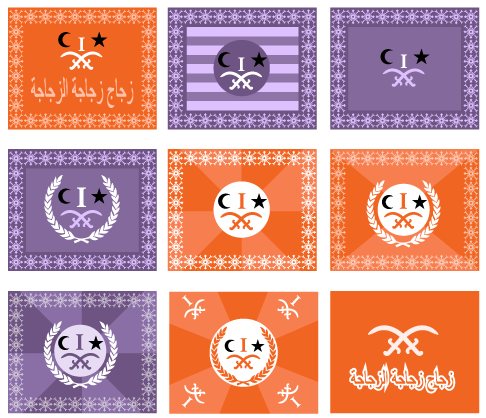 |
| Some of my draft designs for a Burkish flag. |
What I have to work out next is how to turn my digital design into a mini-flag to mount on my toy soldier's flag pole. Not difficult but I will double check some of the TVAG flag designs I got with the Funny Little Wars rules for sizing.
Practically speaking, I got some good tips for making flags from that prolific FLW enthusiast, Mr. Tim Gow. So I'm off into town to buy some double sided sticky tape! I'm looking forward to putting my printed design together as this will be the icing on the cake, so to speak...
Which reminds me, I must buy some tea-cakes today. My daughter is popping by for a visit!
Tuesday, 13 October 2015
Burkish 'command' element progress
Just a small update on my Burkish light infantry regiment, I'm on the last leg - painting the 'command' group (if that's the correct term for the senior NCO and officer). They have a slightly different uniform than the 'other ranks'...
I'm about halfway through painting the figures, so as you can see some of the coats are a bit patchy. But I'm getting through the job pretty quickly (for me).
I'm toying with giving the officer a grey beard, and the flag-carrier needs a flag! This is in the works as well.
I'm about halfway through painting the figures, so as you can see some of the coats are a bit patchy. But I'm getting through the job pretty quickly (for me).
I'm toying with giving the officer a grey beard, and the flag-carrier needs a flag! This is in the works as well.
Sunday, 11 October 2015
IMEX 1/32 Confederate Complete Casson Set review.
As I am interested in my Molaterian field artillery at the moment I thought I should investigate how my field guns might be drawn and what limber they might use. So, I had a look around at what plastic horse artillery caisson or limbers sets there were in 1/32...The short answer is not that many.
What is a 'casson' (or caisson)?
'A caisson is a two-wheeled cart designed to carry artillery ammunition. Caissons are used to bear the casket of the deceased in some state and military funerals in certain Western cultures, including the United States and United Kingdom.' Source: Wikipeadia
While limbers and caissons are two different things, they are often confused. But, generally, the limber is a wheeled support for the 'tail' of a field gun, while a caisson is a wheeled ammunition carrier. The confusion derives from the fact that a caisson can also act as a limber. [Note that IMEX calls it's ACW horse artillery set a 'casson' set. I presume this is due to an American interpretation of the spelling.]
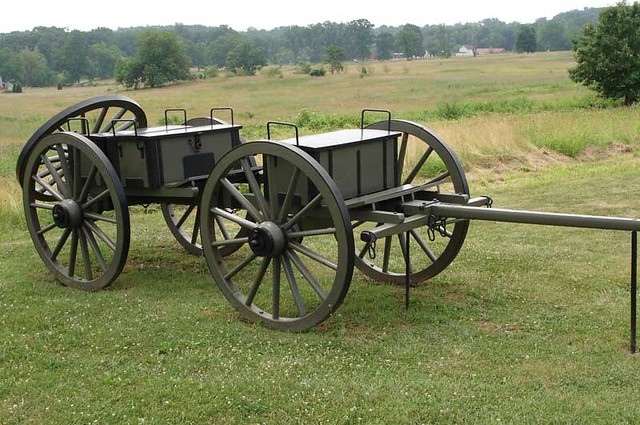 |
| Limber (right) and Caisson. Source: Wikipedia |
Anyhoo...Rather annoyingly, the only 1/32 horse drawn gun set I could find was made by IMEX - an American Civil War horse artillery set. I say annoyingly because - here in the UK - it is rather expensive at £20. Though, to be fair, it is rather a large set which includes horses, caisson, cannon and 18 figures.
As I was unable to find any review of this set, or indeed any photo reference of the contents of the box I bit the bullet, bought it and so I thought I'd produce a review of my own...
The IMEX American Civil War Confederate Complete Casson Set
The first thing you notice with the IMAX 'casson' set is the size of the box (xxx x xxx) - it's a big set!
There is a lot in the big box, with no less than 18 confederate soldiers, 4 horses plus cannon and limber (sorry, 'caisseon'). Eighteen soldiers seems a lot for a single field gun crew, and it is - x of these figures are Confederate infantry armed with Springfield/Enfield rifle-muskets and their officer.
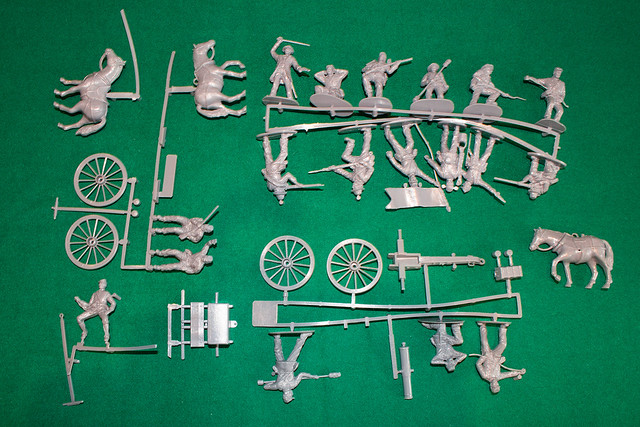 |
| One of the horses went AWOL here...But I found it later! |
The components of this set are plastic, but it is a slightly harder plastic than one normally find with plastic toy soldiers (but not plastic kit hard). This is quite nice with regards to the crispness and rigidity of the soldiers' rifles, a component that so often suffers from bending because of the soft plastics normally used.
Scale-wise the IMEX figures are close to those of - for example - Armies in Plastic, though maybe a little shorter and skinnier. Here's some comparison shots, Armies in Plastic Union artillerymen in blue IMEX Confederates in grey...
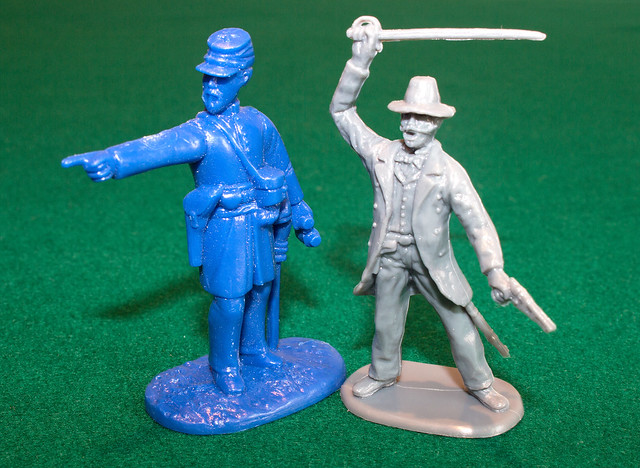 |
| I suppose there isn't that much in it, depends how picky you are! The IMEX chaps have a little more character to them I think though, in their looks and poses. |
Additionally, as you can see from my photos, the sculpting of the figures is a little more detailed or should I say 'gritty' that those of AiP's. By 'gritty' I mean the actual texture of the sculpting, which isn't as smooth as an AiP sculpt. It's a little more 'realistic' in it's attempt to recreate the folds in clothing, whereas AiP are definitely in the toy soldier camp as far as how they portray their subjects (they include less detail and material textures are simplified).
My first impression was that the IMEX Confederates were a little 'raggedy'. But, historically, I guess this was probably fair comment and this is further emphasised by the ad-hoc nature of the 'Rebs' uniforms (indeed the box art illustrates the inclusion of civilian garb as part of the Confederate dress).
 |
| The IMEX gun team figures (probably enough for two guns really). |
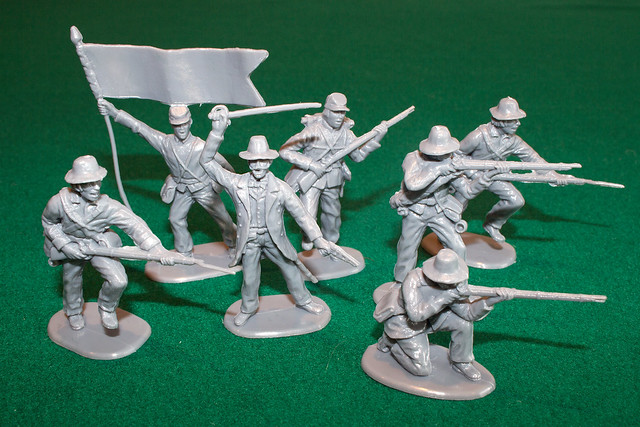 |
| The Confederate infantry platoon that accompanies the IMEX set. |
So these aren't parade ground - beginning of the war - Confederates. But I am sure ACW enthusiats will put me right on this matter!
The horses are a little disappointing. They are rather 'chubby' beasts and there is something a little comical about the expressions on their faces!
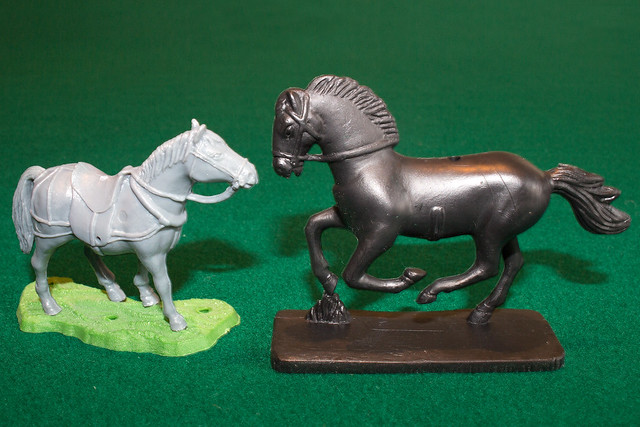 |
| Left: IMEX horse. Right: Armies in Plastic cavalry horse. The stand under the IMEX horse is from another set, it's just there to equal out the height. |
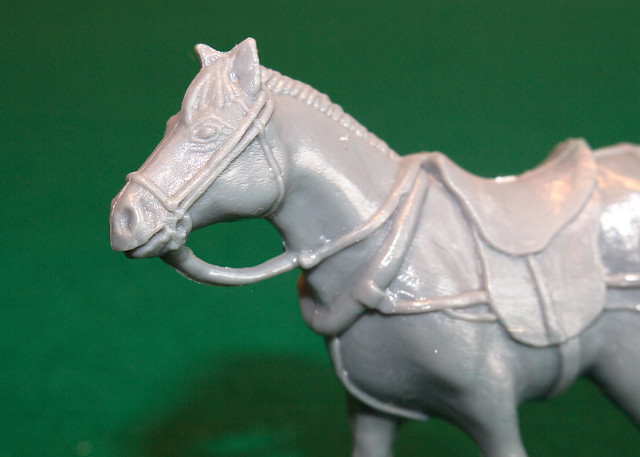 |
| Is he laughing at me? |
The cannon is a nice piece, it's a light gun and I'd even go as far as to guess it's one of the early bronze 1841 Confederate 6 Pounders. This places it as an early ACW piece of field equipment, as by mid-war the 12 Pounder was more prevalent I believe. But I'm no expert, I'm just going by comparing the model to images on the Internet...
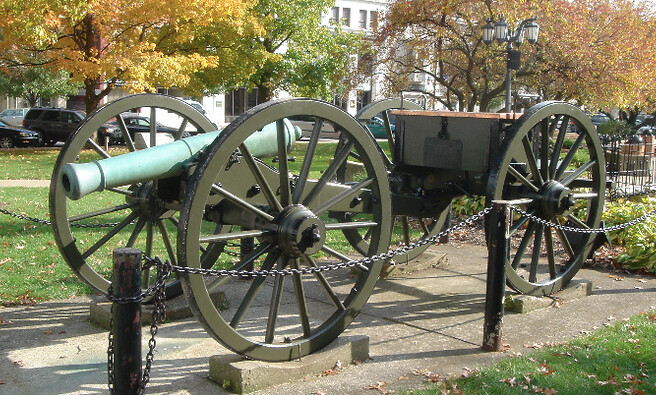 |
| Model 1841 6-pounder attached to its limber. Source: Steencannons.com |
So overall you do get value for money (if you compare the IMEX set's price to box sets made by AiP or Italeri), principally because of the addition of all the extra infantry.
Were I pernickety (and I am) I would be concerned how these figures fit in with my other plastic soldiers. If you have gone down the IMEX route for all of your ACW plastic soldiers then fine, but looking at the IMEX figures next to the AiP ones I'd have to hope that once I'd painted them in a similar style that the variations in scale and sculpting style might no be so noticeable (we shall see when I paint a test figure).
Obviously, one must remember that these toy soldiers - when 'played with' as part of a war game - will be seen from tabletop or even floor distance and so any variations in scale might not be noticeable at all.
In the end though, as this is the only relatively cheap source of a 1/32 plastic full horse artillery team available in the UK you may find yourself with Hobson's Choice.
(I note, with some envy, that our American cousins have access to a wider variety of choice. For example, Classic Toy Soldiers USA make a nice ACW limber in 54mm for just $1.95! And if you want something a little special then Marx make a wonderful Commemorative Reissue of their classic Confederate Limber Play Set which comes with both a limber and a caisson for $22.95!)
--------------------
The IMEX set in the context of my FLW hobby
Having talked about the IMEX set generally I'd just like to add a brief note about the set in context of Funny Little Wars and also from the point of view of my possible use of the set.
Obviously the relevancy of this set is limited as this sort of cannon is more suitable to the mid rather than late 19th century (which is the period which interests me the most). That said there were - historically - situations where this sort of smoothbore cannon was still in use quite late, particularly in colonial campaigns and in the hands of 'native' armies and armies which were less 'modernised' than their European counterparts.
As I mentioned, I really wanted the horse team and limber components of this set for my late 19th century artillery team - particularly for an AiP Krupp 75mm gun project I have in mind - so the 6 Pounder is probably going to the spares box.
As to the figures, the artillery team will convert nicely for the role of Molatarian gunners (and auxiliary troops) but I have a cunning plan in mind for the rest of the Confederate infantry. I would really like to make a regiment of Molatero civilian irregulars, a militia unit in non-military Victorian clothing (would love to convert a few figures into full evening dress, top hats and all)!
Labels:
19th Century,
ACW,
America,
artillery,
Confederate,
horses,
IMEX,
plastic,
soldiers
Friday, 9 October 2015
If it was good enough for Peter Cushing...
Had to post this up as I'm a big fan of Hammer horror movies and Peter Cushing. Finding out that he was an avid toy soldier collector, painter as well as a FLW enthusiast was tremendous. Moreover, this bit of news was charmingly related by a wonderful Pathe News film made in 1956!
Was absolutely entranced by this little film and as the title of this post says, if it's good enough for this icon of British horror it's certainly good enough for me!
Was absolutely entranced by this little film and as the title of this post says, if it's good enough for this icon of British horror it's certainly good enough for me!
Wednesday, 7 October 2015
17 of 20 Burkish!
Getting there (apologies for the count down)! But just finishing off the infantry element of my Burkish regiment, which will leave just the NCO/officer element to complete.
But I can announce the winner of the Groucho Marx look-alike contest...
But I can announce the winner of the Groucho Marx look-alike contest...
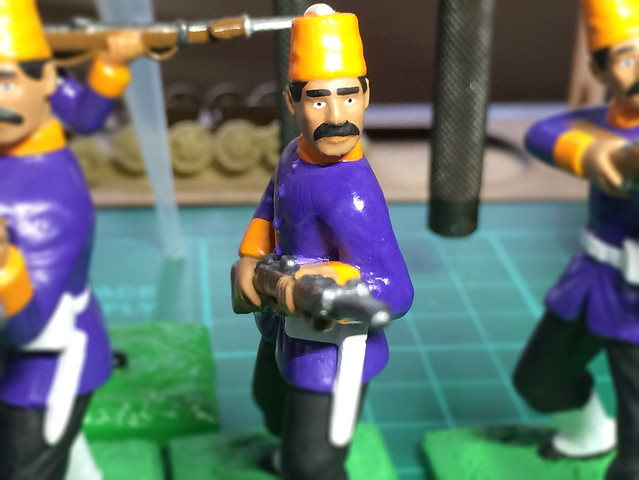 |
| "I never forget a face, but in your case I'll be glad to make an exception." |
(I was so tempted to paint little spectacles on him and give him a cigar!)
Saturday, 3 October 2015
Library additions for October 2015
Aside from the collecting and painting of figures my FLW hobby has lured me into becoming something of a (very) amateur historian of all things 19th and very early 20th century. I've collected a small library of books which cover military campaigns from the Franco-Prussian war (1870) to the Balkan Wars of 1912, mostly reference works about uniforms of the period.
This months additions to my library are rather niche and interesting - I think - and add to the range of scenarios that the FLW player can field.
Osprey's The Russo-Japanese War 1904–05
This is rather topical for me as part of last months pay day treat was my purchase of some Japanese
soldiers by The Virtual Armchair General, so it's interesting to read about a campaign in which these soldiers could be used (from a war gaming point of view). That's not to say I intend to expand my collection of TVAG figures or to war game with them, it's just interesting to have some historical context for the TVAG Japanese.
Additionally, I found it very intriguing to read about a war which is not so well know - at least here in the West. The Russo-Japanese War of 1904 is consigned to the bottom draw of Edwardian era campaigns mainly because it's 'not European' (as we have this tendency to get a little confused about whether Russia is European or not). Furthermore, we tend to be a bit snooty about the idea that a non-European nation - like Japan - could be modern enough (in the context of the 1900s) to merit the same attention as a European or American army of the same period...
Well, as it turned out this was exactly the same sort of misconception that the Russians appeared to be under and boy did they pay the price for their ignorance of the real facts!
Wikipedia entry (should you wish more information): Russo-Japanese War
In actuality, as some of us might be aware - as is related in the excellent movie 'The Last Samurai' - the Japanese enthusiastically embraced Western style modernisation in the mid-19th century and by the 1900s had a very modern and technically sophisticated military. Not only were the Japanese as technically up-to-date as European armies but they showed themselves to be extremely adept in all the latest military theory and strategy as well...Hence Russia's hugely humiliating and unexpected defeat.
Left: Plate from Osprey's book. As much as my emphasis has been on the Japanese involvement the book has some wonderful illustrations of Russian forces. What FLW general wouldn't want a squadron of these Cossacks? Source: Osprey
The Osprey book has - as usual - some wonderful colour plates of the uniforms in use by either belligerent during the war. And it's interesting to note that the Japanese of this time went through the same transition in uniform styles that their European counterparts did just prior to The Great War - from brightly coloured 19th century styled garb to the more subdued 'earthy' 20th century attire.
From an FLW point of view this book would make an ideal companion to AiP's Japanese and Russian plastic soldiers.
MEN-AT-ARMS 414
Author: Alexei Ivanov, Philip Jowett
Illustrator: Andrei Karachtchouk
Short code: MAA 414
Publication Date: 25 Jul 2004
Number of Pages: 48
Link to the book at Osprey's web site: The Russo-Japanese War 1904–05
A World Aflame - Interwar Wargame Rules 1918-39
My second Osprey book this month isn't about uniforms nor, indeed, strictly speaking the classic FLW period. Rather 'A World AFlame' deals with war gaming the inter-war period of 1919 to 1939.
While not strictly a war gamer - let's just call me 'war game curious' - I do find the notion of playing out some of the inter-war scenarios fascinating. It's a very exciting period in my opinion, one which was dominated by the initial clashes of the two giant ideological systems of the age - socialism and fascism. Or, as Osprey puts it:
"A World Aflame captures the adventurous nature of the time period to present a fun, fast-paced set of tabletop miniatures rules that can handle the many diverse conflicts of the period, from the Chinese Civil Wars and the "Great Game” in Central Asia, to the Irish War of Independence and the bitter ideological warfare of the Russian and Spanish Civil Wars."
Left: Women at the Siege of the Alcázar in Toledo, 1936. The Spanish Civil War was but one of the conflagrations of the inter-war period, but it epitomised the growing blurring of the lines between civilians and combatants. Source: Wikipedia
Whether you see this era as the pre-amble to The Second World War (and bear in mind that the Chinese see the start of WW2 as when Japan invaded them in the mid-1930s and not in 1939) or as a revolutionary period or as one of the last great ages of adventure, the inter-war era is a vast resource of 'peculiar wars'. I say peculiar as - at least to me - a proportion of the conflicts of this time were more focused on the involvement of the general populous and their aspirations rather than the sabre-rattling imperialism of the previous century.
Furthermore, I am somewhat intrigued to see how a set of war game rules will capture this aspect of the inter-war conflicts, involve the civilian populous and make provision for popular uprisings and ideological warfare. I'll give my thoughts on this once I've had a good read of the rules.
I am hoping that these game rules can shoe-horn into the actual FLW game rules as a means to expand the basic flexibility of the game. Another option might be to look at Solway's 'A Very British Civil War' gaming rules.
A World Aflame
by Paul Eaglestone
OWG 2
ISBN: 9781849086837
Order ID: 100169343
Link to the book at Osprey's web site: A World Aflame - Interwar Wargame Rules 1918-39
Osprey's The Russo-Japanese War 1904–05
This is rather topical for me as part of last months pay day treat was my purchase of some Japanese
soldiers by The Virtual Armchair General, so it's interesting to read about a campaign in which these soldiers could be used (from a war gaming point of view). That's not to say I intend to expand my collection of TVAG figures or to war game with them, it's just interesting to have some historical context for the TVAG Japanese.
Additionally, I found it very intriguing to read about a war which is not so well know - at least here in the West. The Russo-Japanese War of 1904 is consigned to the bottom draw of Edwardian era campaigns mainly because it's 'not European' (as we have this tendency to get a little confused about whether Russia is European or not). Furthermore, we tend to be a bit snooty about the idea that a non-European nation - like Japan - could be modern enough (in the context of the 1900s) to merit the same attention as a European or American army of the same period...
Well, as it turned out this was exactly the same sort of misconception that the Russians appeared to be under and boy did they pay the price for their ignorance of the real facts!
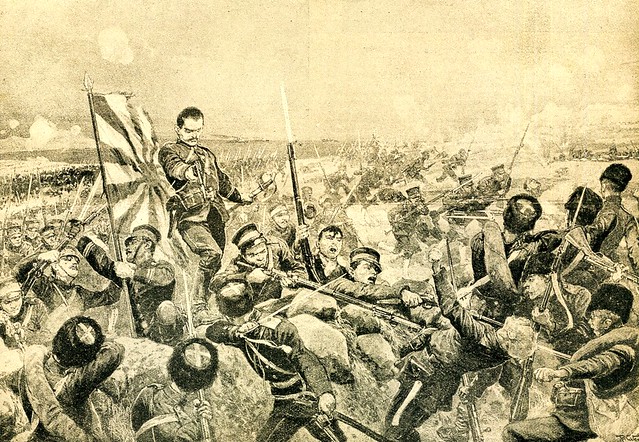 |
| Japanese assault on the entrenched Russian forces, 1904. Source: Wikipedia |
In actuality, as some of us might be aware - as is related in the excellent movie 'The Last Samurai' - the Japanese enthusiastically embraced Western style modernisation in the mid-19th century and by the 1900s had a very modern and technically sophisticated military. Not only were the Japanese as technically up-to-date as European armies but they showed themselves to be extremely adept in all the latest military theory and strategy as well...Hence Russia's hugely humiliating and unexpected defeat.
Left: Plate from Osprey's book. As much as my emphasis has been on the Japanese involvement the book has some wonderful illustrations of Russian forces. What FLW general wouldn't want a squadron of these Cossacks? Source: Osprey
The Osprey book has - as usual - some wonderful colour plates of the uniforms in use by either belligerent during the war. And it's interesting to note that the Japanese of this time went through the same transition in uniform styles that their European counterparts did just prior to The Great War - from brightly coloured 19th century styled garb to the more subdued 'earthy' 20th century attire.
From an FLW point of view this book would make an ideal companion to AiP's Japanese and Russian plastic soldiers.
MEN-AT-ARMS 414
Author: Alexei Ivanov, Philip Jowett
Illustrator: Andrei Karachtchouk
Short code: MAA 414
Publication Date: 25 Jul 2004
Number of Pages: 48
Link to the book at Osprey's web site: The Russo-Japanese War 1904–05
A World Aflame - Interwar Wargame Rules 1918-39
My second Osprey book this month isn't about uniforms nor, indeed, strictly speaking the classic FLW period. Rather 'A World AFlame' deals with war gaming the inter-war period of 1919 to 1939.
While not strictly a war gamer - let's just call me 'war game curious' - I do find the notion of playing out some of the inter-war scenarios fascinating. It's a very exciting period in my opinion, one which was dominated by the initial clashes of the two giant ideological systems of the age - socialism and fascism. Or, as Osprey puts it:
"A World Aflame captures the adventurous nature of the time period to present a fun, fast-paced set of tabletop miniatures rules that can handle the many diverse conflicts of the period, from the Chinese Civil Wars and the "Great Game” in Central Asia, to the Irish War of Independence and the bitter ideological warfare of the Russian and Spanish Civil Wars."
Left: Women at the Siege of the Alcázar in Toledo, 1936. The Spanish Civil War was but one of the conflagrations of the inter-war period, but it epitomised the growing blurring of the lines between civilians and combatants. Source: Wikipedia
Whether you see this era as the pre-amble to The Second World War (and bear in mind that the Chinese see the start of WW2 as when Japan invaded them in the mid-1930s and not in 1939) or as a revolutionary period or as one of the last great ages of adventure, the inter-war era is a vast resource of 'peculiar wars'. I say peculiar as - at least to me - a proportion of the conflicts of this time were more focused on the involvement of the general populous and their aspirations rather than the sabre-rattling imperialism of the previous century.
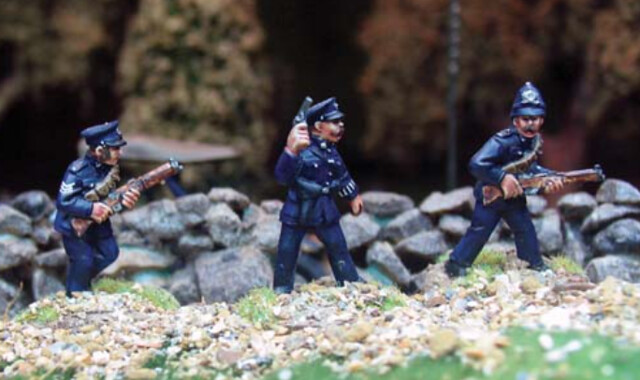 |
| 'British Bobbies on Patrol'. This photo from the book illustrates the greater emphasise there is on irregular, civil and militia forces as belligerents in the game. Source: Osprey. |
I am hoping that these game rules can shoe-horn into the actual FLW game rules as a means to expand the basic flexibility of the game. Another option might be to look at Solway's 'A Very British Civil War' gaming rules.
A World Aflame
by Paul Eaglestone
OWG 2
ISBN: 9781849086837
Order ID: 100169343
Link to the book at Osprey's web site: A World Aflame - Interwar Wargame Rules 1918-39
Subscribe to:
Comments (Atom)
